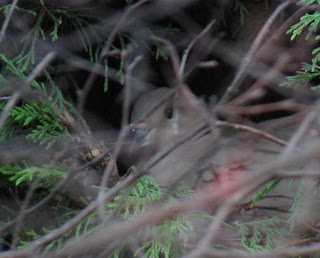I mentioned this back in December, now the results are out, thought I'd add a very short summary of the results as sent out by Stephen. 16 entries in all, with no-one quite managing to break the 100 barrier set in recent years.
The Brett Westwood Cup for Supreme Champion
ROB COLLIS – 98 species. Honourable mention goes to Andrew Dawes with a commendable 90, Andrew’s friend Jack Wylson (honorary entrant) also managed 72 species back home in Kent and Sussex.
I suppose I had better mention Supreme Champion of the past two years, Brett Westwood, who while ‘not really trying’ around his Midlands home, totted up a very creditable 90 species, including Firecrest.
And your competition organiser Stephen Moss managed a respectable 81 species – all in Somerset – And rival Mike Dilger managed just 80 – mind you, he was in Ireland where there are no birds…
The Andrew Dawes Vase for the best Intermediate birder
L MEADOWS – 82, R Gloyns - 72, H Spearing, 71, C Jackson 41
The Chris Cole Trophy for the best Beginner
L COOK – 45, S Comerford - 18
The Adam White Plate for the most species seen with kids in tow…
F BEELEY – 56 species
while racking up no fewer than 11 mammal species – in the unofficial Beeley Cup! These were… "Fallow deer, muntjac, roe deer, stoat, water vole (note: feeding off willow bark), ST field vole, Brown rat (under bird feeders at Longford lakes), grey squirrel, fox, badger, and smelt a polecat in haystack where known polecat lives, but didn't see or hear! – smell counts for BEELEY CUP!"
N Pope - 46, A Griffiths - 33, J Bristow - 28.
The Nigel Bean medal for the highest garden list
S MOSS – 34 species, Apart from L Meadows with 27 species, no-one else bothered to enter this category – not even Nigel!
So that's that for another year, though we are thinking of having a May birdwatch, set up the scopes and help those who are new to birding to id species.
Today, also had another stationary watch at Sand Bay, just half an hour this time before work. Weather was dull again, so using the scope was tough, tide was just on the turn at 8.30.
Sat image, I stand on the beach side of the caravan park on the right. Tide will advance to the light green shadow on the marsh, and then receed again 200m. Top of picture is Sand Point.
100+ Black Headed Gull, 1 Lsr Black Back Gull, 50-70 Shelduck (bobbling on the sea), 6 Linnet, 40+ Curlew, 2 Carrion Crow, 4 Mallard, flock of 7 Common Gull overhead, 4 Greenshank and singles of Wren, House Sparrow, Robin, Skylark, Chaffinch and Dunnock.
Driving in noticed the primroses are at last coming into flower, and a huge gull flock of several hundreds alongside the M5 - rich pickings in that field then











































